List of Armenian monarchs
This is a list of the monarchs of Armenia, for more information on ancient Armenia and Armenians, please see History of Armenia. For information on the medieval Armenian Kingdom in Cilicia, please see the separate page Armenian Kingdom of Cilicia.
See List of kings of Urartu for kings of Urartu (Ararat), the predecessor state of Greater Armenia.
Greater Armenia
This is the historical designation of the largest and longest-lasting Armenian kingdom.
Orontid kings and satraps
In Armenian tradition
Early kings in traditional Armenian chronology according to Moses of Chorene.
Note that the early dates are traditional and of uncertain accuracy.
- Orontes I Sakavakyats (570–560 BC)
- Tigranes Orontid (560–535 BC)
- Vahagn (530–515 BC)
- Hidarnes I (late 6th century BC)
- Hidarnes II (early 5th century BC)
- Hidarnes III (middle of the 5th century BC)
- Ardashir (2nd half of the 5th century BC)
Attested satraps
- Orontes (401–344 BC)
- Darius Codomannus (344–336 BC)
Yervandian (Yervanduni or Orontid) Dynasty
- Orontes II (336–331 BC)
- Mithranes (331–323 BC)
- Neoptolemus Orontid (non-dynastic) (323–321 BC)
- Mithranes (331–321 BC)
- Orontes III (321–260 BC)
- Sames (260–243 BC)
- Arsames (243–228 BC)
- Xerxes (228–212 BC)
- Orontes IV (212–200 BC)
Artashesian (Artaxiad) Dynasty
- Artaxias I (190–159 BC)
- Artavasdes I (159–123 BC)
- Tigranes I (123–95 BC)
- Tigranes the Great (Tigranes II, 95–55 BC)
- Artavasdes II (55–34 BC)
- Artaxias II (33–20 BC)
- Tigranes III (20–10 BC)
- Tigranes IV with Erato (10 BC–2 BC)
Roman and Parthian non-dynastic candidates
- Ariobarzanes, 2 BC to 4 (Roman protectorate)
- Artavasdes III[contradictory] 4 to 6
- Tigranes V, 6 then ruled with Erato 6–12
- Vonones (former king of Parthia) 12–16 (Roman protectorate)
- Roman interregnum 16–18 (Vonones as nominal king)
- Artaxias III 18–35 (Roman protectorate)
- Arsaces I of Armenia (son of Artabanus III) 35 (Parthian protectorate)
- Orodes of Armenia (pretender, son of Artabanus III) 35
- Mithridates 35–37 (Roman protectorate)
- Orodes (now king) 37–42 (Parthian protectorate)
- Mithridates (second time) 42–51 (Roman protectorate)
- Rhadamistus (son of Pharasmanes I of Iberia) 51–53 (Roman protectorate)
- Tiridates I (son of Vonones II of Parthia) 53 (Roman protectorate)
- Rhadamistus (second time) 53–54 (Roman protectorate)
Arshakuni (Arsacid) Kings of Armenia
- Tiridates I (second time) 52–58
- Tigranes VI 59–62 (Roman protectorate)
- Tiridates I 62–88 (Parthian protectorate 62–63; from 63 Armenia again becomes a Roman protectorate)
- Sanatruces (Sanatruk) 88–110
- Axidares (Ashkhadar) 110–113
- Parthamasiris (Partamasir) 113–114
- Roman Province 114–117/8
- Vologases I (Vagharsh I) 117/8–144
- Sohaemus 144–161
- Bakur 161–164
- Sohaemus (second time) 163/4–186?
- Vologases II (Vagharsh II) 186–198
- Khosrov I 198–217
- Tiridates II 217–252
- Khosrov II c. 252
- Sassanid Occupation 252–287
- Artavasdes IV 252–287 Sassanid Client King
- Tiridates III 287–330 (Roman protectorate again)
- Khosrov III 330–339
- Tigranes VII (Tiran) 339 – c. 350
- Arsaces II (Arshak II) c. 350–368
- Sassanid Occupation 368
- Papas (Pap) 370–374
- Varasdates (Varazdat) 374–378
- Arsaces III (Arshak III) 378–387 with co-ruler Vologases III (Vagharsh III) 378–386
- Khosrov IV 387–389
- Vramshapuh 389–417
- Local Independent Government 417–422
- Artaxias IV (Artashir IV) 422–428
Presiding Marzbans and Princes of Armenia
| Ruler | Reign | Family | Ruling part | Overlord | Notes | |
|---|---|---|---|---|---|---|
| Veh Mir Shapur | 428–442 | N.D. | Marzpanate of Armenia |
|
Iranian lord. | |
| Vasak | 442–451 | Siunia | Marzpanate of Armenia |
|
Armenian noble. | |
| Adhur Hormizd | 451–465 | N.D. | Marzpanate of Armenia |
|
Iranian lord. | |
| Adhur Gushnasp | 465–481 | N.D. | Marzpanate of Armenia |
|
Iranian lord. | |
| Sahak II | 481–482 | Bagratuni | Marzpanate of Armenia | Armenian nobleman, elected by the rebellious Armenian nobles. Killed at the Battle of Akesga. | ||
| Shapur Mihran | 482 | N.D. | Marzpanate of Armenia | Iranian military occupation. | ||
| Vahan I | 482–483 | Mamikonian | Marzpanate of Armenia | Armenian nobleman. 1st time, as Head of provisional government. | ||
| Zarmihr Hazarwuxt | 483 | Karen | Marzpanate of Armenia | Iranian military occupation. | ||
| Shapur | 483–484 | Mihran | Marzpanate of Armenia | Iranian lord Cyril Toumanoff suggests a marzpan named Andigan for the same period.[1] | ||
| Vahan I | 484–505 | Mamikonian | Marzpanate of Armenia | 2nd time. | ||
| Vard | 505–514 | Mamikonian | Marzpanate of Armenia |
|
||
| Gushnasp Bahram | 514–518 | N.D. | Marzpanate of Armenia | 1st time. Somes experts insert here various short rules. According to Samuel of Ani : "After the patrician Vard, brother of Vahan, Iranian marzpans governed Armenia for 11 years ... The government of Armenia passed then to Mjej of the Gnuni family, who exercised it for 30 years".[2] | ||
| Mjej I | 518–548 | Gnuni | Marzpanate of Armenia | Mentioned by Cyril Toumanoff[1] and Gérard Dédéyan,[3] but not included by René Grousset. | ||
| Gushnasp Bahram | 548–552[1] or 552–554[4] | N.D. | Marzpanate of Armenia |
|
Iranian lord. 2nd time. | |
| Tan-Shapur | 552–560[1] or 554–560[4] | N.D. | Marzpanate of Armenia | Iranian lord. | ||
| Varazdat | 560–564 | N.D. | Marzpanate of Armenia | Iranian lord. | ||
| Chihor-Vishnasp | 564–572 | Suren | Marzpanate of Armenia | Iranian lord. | ||
| Mihran Mihrevandak | 572 | N.D. | Marzpanate of Armenia | Iranian military occupation. | ||
| Vardan III | 572–573 | Mamikonian | Marzpanate of Armenia | Armenian nobleman and leader of anti-Iranian rebellion.[4] 1st time. | ||
| Golon Mihran | 573–574 | N.D. | Marzpanate of Armenia | Iranian lord. | ||
| Vardan III | 574–577 | Mamikonian | Marzpanate of Armenia | 2nd time. | ||
| Tamkhosrow | 577–579 | N.D. | Marzpanate of Armenia | Iranian lord. | ||
| Varaz Vzur | 579 | N.D. | Marzpanate of Armenia |
|
Iranian lord. | |
| Pahlav | 579–586 | N.D. | Marzpanate of Armenia | Iranian lord. | ||
| Frahat | 586–590 | N.D. | Marzpanate of Armenia | Iranian lord. | ||
| Hrartin | 590–591 | N.D. | Marzpanate of Armenia |
|
Iranian lord. | |
| Musel II | 591 | Mamikonian | Province of Armenia |
|
Brief Byzantine occupation. | |
| Vindatakan | 591–605 | N.D. | Marzpanate of Armenia |
|
Possible marzbans, according to Cyril Toumanoff. | |
| Nakhvefaghan | N.D. | Marzpanate of Armenia | ||||
| Merakhbut | N.D. | Marzpanate of Armenia | ||||
| Yazden | N.D. | Marzpanate of Armenia | ||||
| Butmah | N.D. | Marzpanate of Armenia | ||||
| Smbat IV | 605–611 | Bagratuni | Marzpanate of Armenia | Christian Settipani records him as marzpan from 599 to 607.[5] He is not mentioned as marzpan by Toumanoff. René Grousset holds that Khosrau II named him marzpan following his victories in Hyrcania, ca. 604, and adds that he possibly continued in office until his death in 616–617.[6] However, he also mentions three other marzpans over the same period (see following).[7] | ||
| Schahrayeanpet | 611–613 | N.D. | Marzpanate of Armenia | Iranian lord. Marzpan at Dvin, in eastern Armenia, along with Shahin Vahmanzadegan as pahghospan in western (former Byzantine) Armenia . | ||
| Parsayenpet | 613–616 | N.D. | Marzpanate of Armenia | Iranian lord. | ||
| Namdar-Gouchnasp | 616–619 | N.D. | Marzpanate of Armenia | Iranian lord. | ||
| Shahraplakan | 619–624 | N.D. | Marzpanate of Armenia | Iranian lord. | ||
| Rotchvehan | 624–627 | N.D. | Marzpanate of Armenia | Iranian lord. | ||
| Vacancy: 627–628 | Marzpanate of Armenia |
|
Vacancy: 627–628 | |||
| Varaztirots II | 628–633 | Bagratuni | Marzpanate of Armenia |
|
Armenian nobleman, named marzpan by Kavadh II for the portions of Armenia remaining under Iranian rule. Following the onset of the Muslim conquest of Iran, Varaztirots aligned himself with the Byzantines. | |
| 633–634 | Province of Armenia |
| ||||
| Mjej II | 634–635 | Gnuni | Province of Armenia | Installed by the Byzantines. | ||
| David Kouropalates | 635–638 | Saharuni | Province of Armenia | Armenian nobleman, he murdered Mjej and proclaimed himself governor. He was recognized by Heraclius, who named him kouropalates and ishkhan of Armenia. | ||
| Period with no centralized authority:638–643 | Province of Armenia |
|
Period with no centralized authority:638–643 | |||
| Theodore | 643–645 | Rshtuni | Province of Armenia |
|
Recognized by the Byzantines after a victory against the Arabs. 1st time. | |
| Varaztirots II | 645–646 | Bagratuni | Province of Armenia | Following the complete collapse of Iran, he was named Prince of Armenia by the Byzantines, but died before being formally invested. | ||
| Theodore | 646–652 | Rshtuni | Province of Armenia | 2nd time for Theodore, rule with Smbat V Bagratuni, son of Varaztirots II. In 652, they recognized Arab suzerainty. | ||
| 652–654 | Emirate of Armenia |
| ||||
| Smbat V | 646–652 | Bagratuni | Province of Armenia |
| ||
| 652–653 | Emirate of Armenia |
| ||||
| Musel IV | 654 | Mamikonian | Emirate of Armenia | Expelled Theodoros, but he returned to power that same year. | ||
| Theodore | 654–655 | Rshtuni | Emirate of Armenia | 3rd time. Under his third rule, Maurianos, a Byzantine governor, was installed in Armenia. | ||
| Maurianos | 654–655 (in opposition) |
N.D. | Province of Armenia |
|
Installed by the Byzantines, ruled concurrently against Theodore Rshtuni. | |
| Hamazasp | 655–661 | Mamikonian | Emirate of Armenia |
|
The Arabs appointed Habîb ibn-Maslama as vassal governor for the prince. | |
| Grigor I | 661–685 | Mamikonian | Emirate of Armenia |
|
||
| Ashot II | 685–688 | Bagratuni | Emirate of Armenia |
|
||
| Nerseh | 688–691 | Kamsarakan | Province of Armenia |
|
In 688, the Byzantine Empire recovers Armenia. | |
| Smbat VI Kouropalates | 691–698 | Bagratuni | Emirate of Armenia |
|
Son of Varaztirots III Bagratuni. Shifted alliances between the Byzantines and the Arabs.
Arab vassal governors:
| |
| 698–706 | Province of Armenia |
| ||||
| 706–726 | Emirate of Armenia |
| ||||
| Artavazd | 726–732 | Kamsarakan | Emirate of Armenia |
|
Arab vassal governors:
| |
| Ashot III the Blind | 732–745 | Bagratuni | Emirate of Armenia |
|
1st time. Arab vassal governors:
| |
| Grigor II | 745–746 | Mamikonian | Emirate of Armenia |
|
1st time. Arab vassal governors:
| |
| Ashot III the Blind | 746–748 | Bagratuni | Emirate of Armenia | 2nd time. Arab vassal governors:
| ||
| Grigor II | 748 | Mamikonian | Emirate of Armenia | 2nd time. Arab vassal governors: | ||
| Musel VI | 748–753 | Mamikonian | Emirate of Armenia |
|
Brother of Grigor II. Arab vassal governors:
| |
| Sahak III | 753–761 | Bagratuni | Emirate of Armenia |
|
Also Lord of Taron. Arab vassal governors:
| |
| Smbat VII | 761–772 | Bagratuni | Emirate of Armenia |
|
Arab vassal governors:
| |
| Vacancy: 772–780 | Emirate of Armenia |
|
Arab vassal governors (probably more independent in the period):
| |||
| Tatzates | 780–785 | Andzevatsi | Emirate of Armenia |
|
Arab vassal governors:
| |
| Vacancy: 785–806 | Emirate of Armenia |
|
Arab vassal governors (probably more independent in the period):
| |||
| Ashot IV the Carnivorous | 806–826 | Bagratuni | Emirate of Armenia |
|
Arab vassal governors:
| |
| Smbat VIII the Confessor | 826–856 | Bagratuni | Emirate of Armenia |
|
Brothers, ruled jointly.[8] Arab vassal governors:
| |
| Bagrat II | 830–852 | Bagratuni | Emirate of Armenia | |||
| Ashot V the Great | 856–884 | Bagratuni | Emirate of Armenia |
|
In 884, he finally sets an independent kingdom of Armenis, freeing it from the Arabs. Arab vassal governors (until 884):
| |
Armenian Bagratid kingdom and vassals
Bagratuni dynasty
| Ruler | Born | Reign | Death | Ruling part | Consort | Notes | |
|---|---|---|---|---|---|---|---|
| Ashot I the Great (Աշոտ Ա) |
c.820 Son of Smbat VIII Bagratuni and Ripsime |
884–890 | 890 Gugark aged 69/70 |
Kingdom of Armenia | Katranide of Armenia I seven children |
Crowned king in 884, with the consent of Al-Mu'tamid, to prevent Byzantine invasion in the land, as its emperor, Basil I, had Armenian origins. | |
| Smbat I the Martyr (Սմբատ Ա) |
c.850 Son of Ashot I and Katranide of Armenia I |
890–914 | 914 Yernjak aged 63/64 |
Kingdom of Armenia | Unknown two children |
Continued his father's policy of maintaining cordial relations with the Byzantine Empire, but remained mindful of the Arabs' fears of the Armeno-Byzantine alliance. | |
| Ashot II the Iron (Աշոտ Բ) |
c.880 Son of Smbat I |
914–929 | 929 (aged around 48–49) |
Kingdom of Armenia | Sahakanuysh of Gardman[9] no children |
His reign was filled with rebellions by pretenders to the throne, and foreign invasions, which Ashot fought off successfully. However, he left no descendants. The throne passed to his brother. | |
| Abas I (Աբաս Ա) |
c.880 Son of Smbat I |
929–953 | 953 aged around 72–73 |
Kingdom of Armenia | Gurandukht Bagratuni two children |
Abas' reign was marked by years of peace, stability, and prosperity for Armenia. | |
| Ashot III the Merciful (Աշոտ Գ Ողորմած) |
c.916 Son of Abas I and Gurandukht Bagratuni |
953–977 | 3 January or 20 May 977 aged 60–61 |
Kingdom of Armenia | Khosrovanuysh four children |
Moved his royal seat of residence to Ani and oversaw its development and of the kingdom as a whole. Armenia reached the height of its golden era during his reign and that of his sons and successors. | |
| Musel (Մուշեղ Ա) |
c.920? Son of Abas I of Armenia and Gurandukht Bagratuni |
963–984 | 984 aged around 63/64? |
Kingdom of Kars | Unknown (daughter of Prince Sevada II of Gardman) four children |
From 963, ruled in his own state of Kars, created as a vassal state. In 977 contested the succession of his nephew Smbat II. | |
| Smbat II the Conqueror (Սմբատ Բ նվաճողը) |

|
c.940? Ani Son of Ashot III and Khosrovanuysh |
977–989 | 989 Ani aged around 48–49 |
Kingdom of Armenia | Unmarried | He left no descendants. The throne passed to his brother Abas. |
| Gurgen I (Գուրգեն Ա) |
c.940? Ani Son of Ashot III and Khosrovanuysh |
979–989 | 989 Matsnaberd aged around 48–49 |
Kingdom of Tashir-Dzoraget | Unknown two children |
From 979, ruled in his own state of Tashir-Dzoraget, created as a vassal state. | |
| Abas I (Աբաս Ա) |
? Son of Musel |
984–1029 | 1029 | Kingdom of Kars | Kata of Georgia one child |
Helped David II of Georgia, who wanted to take Manzikert, against the Emirate of Azerbaijan. | |
| Gagik I (Գագիկ Ա) |
c.950? Ani Son of Ashot III and Khosrovanuysh |
989–1020 | 1020 Ani aged around 69–70 |
Kingdom of Armenia | Katranide of Armenia II three children |
||
| David I the Landless (Դավիթ Անհողին) |
? Matsnaberd Son of Gurgen I |
989–1048 | 1048 Matsnaberd |
Kingdom of Tashir-Dzoraget | Zolakertel of Kakheti four children |
During his reign he lost temporarily his lands to the main kingdom of Ani, hence his nickname. | |
| Hovhannes-Smbat (III) (Հովհաննես–Սմբատ (Գ)) |
c.975? Ani Son of Gagik I and Katranide of Armenia II |
1020–1041 | 1041 Ani aged around 71–72? |
Kingdom of Armenia | Unmarried | ||
| Ashot IV the Valiant (Աշոտ Դ Քաջ) |
c.975? Ani Son of Gagik I and Katranide of Armenia II |
1020–1040 | 1040 Ani aged around 70–71? |
Kingdom of Armenia | Unknown one child |
Rebelled against his brother and made himself crowned king in various Armenian provinces. | |
| Gagik-Abas II (Գագիկ-Աբաս Բ) |

|
? Son of Abas I and Kata of Georgia |
1029–1064 | 1064 | Kingdom of Kars | Gurandukht of Cilicia[10] one child |
His good relations with Alp Arslan spared him from the invasion of the Seljuks in Ani. However, to secure protection, Gagik Abas sold his kingdom to Constantine X Doukas, in exchange with some towns in Cappadocia. |
| Kars annexed to the Byzantine Empire | |||||||
| Gagik II (Գագիկ Բ) |
1024 Ani Son of Ashot IV |
1040/41–1045 | 24 November 1079 Caesarea Mazaca aged around 74–75 |
Kingdom of Armenia | Unknown one child |
He was enthroned as Gagik II and ruled for a brief period from 1042 to 1045, before the Bagratid dynasty rule collapsed in Armenia. He survived and died in 1076. | |
| Armenia annexed by: the Byzantine Empire (1045–1064), the Turko-Persian Seljuk Empire (1064–1072) and the Muslim Shaddadids (1072–1199) | |||||||
| Gurgen II (Կյուրիկե Բ) |

|
? Matsnaberd Son of David I and Zolakertel of Kakheti |
1048–1089 | 1089 Lori |
Kingdom of Tashir-Dzoraget | Unknown three children |
Changed the capital of the kingdom to Lori in 1065. |
| David II (Դավիթ Բ) |
? Lori Son of Gurgen II |
1089–1118 1118–1145 |
1145? Matsnaberd |
Kingdom of Tashir-Dzoraget Lordship of Matsnaberd and Tavouch |
Mamka three children |
They returned their capital to Matsnaberd in 1111. In 1118, the kingdom was annexed to Georgia. Despite keeping the royal title, they continued to rule as Lords of Matsnaberd and Tavouch, then as vassals of the Kings of Georgia. Vassals of:
| |
| Abas I (Աբաս Ա) |
? Lori Son of Gurgen II |
1145 Matsnaberd |
Ruzka no children | ||||
| Gurgen III (Կյուրիկե Գ) |
? Matsnaberd Son of David II and Ruzka |
1145–1185 | 1185 Matsnaberd |
Lordship of Matsnaberd and Tavouch | Tamar six children |
Vassal of:
| |
| Abas II (Աբաս Բ) |
1173 Matsnaberd Son of Gurgen III and Tamar |
1185–1192 | 1192 Matsnaberd |
Lordship of Matsnaberd and Tavouch | Nana of Armenia (Daughter of a Zakarid prince) one child |
Vassal of:
| |
| Aghsartan (Աղսարթան) |
? Matsnaberd Sson of Abas II and Nana of Armenia |
1192–1236 | 1236 Matsnaberd |
Lordship of Matsnaberd and Tavouch | Unknown one child |
Vassal of:
| |
| Gurgen IV (Աբաս Բ) |
1173 Matsnaberd Son of Aghsartan and Nana of Armenia |
1232–1236 | 1236 Matsnaberd |
Lordship of Matsnaberd and Tavouch | Unknown three children |
Co-ruled with his father. He is probably the last ruling member of the family. There are two more rulers, which probably do not belong already to the family, which were vassals to Rusudan of Georgia and David VI of Georgia:
| |
| Matsnaberd and Tavouch merged in Georgia | |||||||
Princes and Kings of Vaspurakan (800–1021)
Artsruni dynasty as princes
- 800–836: Hamazasp II, married to a daughter of Ashot Msaker of the Bagratuni family.
- 836–852: Ashot I Abulabus, son, 1st time
- 852–853: Gurgen I, brother of the above
- 853–854: Abu Djafar, probably brother of the above
- 854–857: Gurgen II, a distant relative from Mardastan
- 857–868: Grigor-Derenik, son of Ashot I, married Sofia, daughter of Ashot I Bagratuni. 1st time
- 868–874: Ashot I Abulabus, 2nd time
- 874–887: Grigor-Derenik, 2nd time.
- 887–898: Gagik Abu Morvan Artsruni, regent for Grigor-Derenik's sons, then usurper from 896
- 898–900: Ashot II Sargis, son of Grigor-Derenik.
- (Vaspurakan occupied in 900–01 by the Sajid emir Afshin)
- Safi, governor
- 901–904: Ashot II Sargis, reinstated. After his death Vaspurakan is divided:
- 904–908: Gagik III, brother of Ashot II, ruler in northwest Vaspurakan, crowned king 908
- 904–925: Gurgen III, brother of Ashot II, ruler in southeast Vaspurakan.
Artsruni dynasty as kings
- 908/25–943: Gagik I (III), brother of Ashot II, ruler in northwest, reunited Vaspurakan 925
- 943–953: Derenik-Ashot I (III), son of the above
- 953–972: Abusahl-Hamazasp, brother of the above
- 972–983: Ashot II Sahak (IV), son of the above
- 983–1003: Gurgen I Khachik (IV), brother of the above, also lord of Antzevasiq.
- 1003–1021: Seneqerim-Hovhannes, brother of the above, also lord of Rechtuniq.
Kings of Syunik (987–1170)
Siunia dynasty
- 987–998: Smbat I Sahak
- 998–1040: Vasak, son of the above
- 1040–1044/51: Smbat II, maternal grandson of the above
- 1044/51–1072: Grigor I, brother of the above
- 1072–1094: Seneqerim, brother-in-law of the above
- 1094–1166: Grigor II, son of the above
- 1166–1170: Hasan, son-in-law of the above
Kings of Georgia
Bagrationi dynasty (1118–1476)
- 1118–1124: David IV the Builder
- 1125–1156: Demetrius I
- 1156–1184: George III
- 1184–1213: Tamar the Great
- 1213–1223: George IV
- 1223–1245: Rusudan
- 1245–1247: David VI
- 1247–1270: David VII
- 1270–1289: Demetrius II the Self-Sacrificer
- 1289–1292: Vakhtang II
- 1292–1311: David VIII
- 1311–1313: George VI Mtsire
- 1299–1346: George V the Brilliant
- 1346–1360: David IX
- 1360–1393: Bagrat V
- 1393–1407: George VII
- 1407–1411: Constantine I
- 1412–1442: Alexander I the Great
- 1430: Qara Iskander, ruler of Kara Koyunlu declares himself to be “Shah-i-Arman”
Armenians in exile: The Armenian Kingdom of Cilicia
The Armenian Kingdom of Cilicia was a state formed in the Middle Ages by Armenian refugees, who were fleeing the Seljuk invasion of Armenia.[11] It was initially founded by the Rubenian dynasty, an offshoot of the larger Bagratid family that at various times held the thrones of Armenia and Georgia. While the Rubenian rulers were initially regional princes, their close ties with the Western world after the First Crusade saw the principality recognised as a kingdom under Leo I by the Holy Roman Empire in 1198.[12] The Rubenid dynasty fell in 1252 after the death of the last Rubenid monarch Isabella, and her husband Hethum I became sole ruler, beginning the Hethumid dynasty. After the death of Leo IV in 1341 his cousin was elected to succeed him as Constantine II, the first king of the Lusignan dynasty. The kingdom fell at the beginning of Leo V's reign to the Mamluks,[13] and henceforth title holders were only claimants to the throne. Charlotte of Cyprus ceded the throne to the House of Savoy in 1485,[14] and the title fell out of use until after 1861.
Lords and Princes of Cilician Armenia Kings of Cilician Armenia
Rubenian dynasty
| Ruler | Born | Reign | Death | Consort | Notes | |
|---|---|---|---|---|---|---|
| Ruben I (Ռուբեն Ա) |
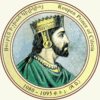
|
1025[15]/35 [16] Unknown |
1080–1095 | 1095 Kormogolo[17] aged 59–60 or 69–70 |
Unknown two children |
He declared the independence of Cilicia from the Byzantine Empire, thus formally founding the beginning of Armenian rule there.[18] The Roupenian dynasty ruled Cilician Armenia until 1219. |
| Constantine I (Կոստանդին Ա) |

|
1035–1040[19] or 1050–1055 Son of Ruben I |
1095–c.1100 | c.1100[20] or 24 February 1102 or 23 February 1103 [16] aged approximately 50–60 |
Unknown (great-granddaughter of Bardas Phokas) three children |
He provided ample provisions to the Crusaders, for example during the difficult period of the siege of Antioch in the winter of 1097. He was a passionate adherent of the separated Armenian Church. |
| Thoros I (Թորոս Ա) |
Unknown, before 1100 First son of Constantine I |
c.1100–1129 | 17 February 1129[21] or 16 February 1130 [16] | Unknown two children |
His alliance with the leaders of the First Crusade helped him rule his feudal holdings with commanding authority. He avenged the death of King Gagik II by killing his assassins. He also bestowed favors and gave gifts and money to many monasteries for their decoration and adornment. | |
| Constantine II (Կոստանդին Բ) |
Before 1129 Son of Thoros I |
1129/1130 | After 17 February 1129 | Unmarried | He died a few months after his father's death in the course of a palace intrigue. | |
| Leo I (Լեիոն Ա) |
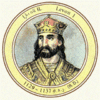
|
Before 1100 Second son of Constantine I |
1129/30–1137 | 14 February 1140 Constantinople aged at least 39–40 |
Unknown six or seven children |
Most of his successes benefited from Byzantium's pre-occupation with the threats of Zengi from Aleppo and the lack of effective Frankish rule, especially in the Principality of Antioch. He expanded his rule over the Cilician plains and even to the Mediterranean shores. He was taken captive in 1137 with two of his sons by the Byzantine Emperor. He died in prison. |
| Byzantine Rule: 1137–1144/1145 | ||||||
| Thoros II the Great (Թորոս Բ) |
1144[16] or 1145[22][23] Son of Leo I |
1144–1169 | 6 February 1169[24][25][16] aged 23–25 |
Unknown (An unnamed daughter of Simon of Raban[26][23]) or Isabelle of Edessa[16] 1149 two children Unknown (An unnamed daughter of Thomas of Cilicia) 1164 one child |
Thoros survived his incarceration in Constantinople and was able to escape in 1143. He found it occupied by many Greek garrisons, ousting successfully the Byzantine garrisons. | |
| Ruben II (Ռուբեն Բ) (under guardianship of Thomas of Cilicia[27]) |
1165 Son of Thoros II |
1169–1170 | 1170 aged 4–5 |
Unmarried | Placed under regency of his maternal grandfather, Thomas of Cilicia. Both monarch and regent were assassinated by prince Mleh, who took the power to himself. | |
| Mleh (Մլեհ) |
Before 1120 Son of Leo I |
1170–1175 usurper |
15 May 1175 Sis aged at least 54–55 |
Unknown no children |
During his father's captivity escaped to Edessa with two of his brothers. Expelled from Cilicia by Thoros II, for embracing the Muslim faith, almost undid his brother's work when he took the power. | |
| Ruben III (Ռուբեն Գ) |
1145 First son of Stephen of Armenia and Rita of Barbaron |
1175–1187 | 6 May 1187[16] Drazark[28] aged 41–42 |
Isabella of Toron two children |
Grandson of Leo I. He was a friend of the Franks (the Crusaders); for example, at the end of 1177, assisted Philip, Count of Flanders and Prince Bohemond III of Antioch at the ineffectual siege of Harenc.[25] | |
| Leo II the Magnificent (Լեւոն Ա Մեծագործ) (Leo I as king) |

|
1150 Second son of Stephen of Armenia and Rita of Barbaron |
1187–1198/9 | 2 May 1219[16] aged 68–69 |
Isabella of Antioch 3 February 1188 or 4 February 1189 (annulled 1206) one child Sibylla of Cyprus 28 January 1210 or 27 January 1211 one child |
In 1194–1195, when he was planning to receive the title of king, he instituted a union of the Armenian church with Rome. During his reign, succeeded in establishing Cilician Armenia as a powerful and a unified Christian state with a pre-eminence in political affairs.[29] Led his kingdom alongside the armies of the Third Crusade and aided the crusaders. Under his rule, Armenian power in Cilicia was at its apogee: his kingdom extended from Isauria to the Amanus Mountains. |
| 1198/9 – 1219 | ||||||
| Isabella I (Զապել) (under guardianship of Adam of Baghras (1219–20) and Constantine of Barbaron (1220–26)) |

|
27 January 1216 or 25 January 1217 Daughter of Leo II and Sibylla of Cyprus |
1219–1252 | 23 January 1252 Ked aged 35–37 |
Philip of Antioch June 1222 no children Hethum I 14 June 1226 Tarsus seven children |
A period of dynastic conflict that ended with the apparent unification in marriage of the two principal dynastic forces of Cilicia (i.e., the Roupenids and the Hethumids). The country experienced struggles and shifting alliances between Crusader states and the Mongol Empire. |
Hethumid dynasty
| Ruler | Born | Reign | Death | Consort | Notes | |
|---|---|---|---|---|---|---|
| Hethum I (Հեթում Ա) |

|
1215 Son of Constantine of Barbaron[30] and Alice Pahlavouni |
1226–1270 (with Isabella I until 1252) |
21 October 1270 aged 54–55 |
Isabella I 14 June 1226 Tarsus seven children |
Was a major player in the political struggles and shifting alliances around the Crusader states, as the Armenians had ties with all sides. They were primarily aligned with the Europeans, but during Hethum's reign, the rapidly expanding Mongol Empire became a concern. |
| Leo III (Լեւոն Բ) (Leo II as king) |
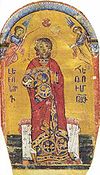
|
1236 Son of Hethum I and Isabella I |
1270–1289 | 6 February 1289 aged 52–53 |
Anna of Lampron 5 January 1262 or 14 January 1263 sixteen children |
A pious king, he was devoted to Christianity. He pursued active commercial relations with the West, by renewing trade agreements with the Italians and establishing new ones with the Catalans. He also endeavoured to reinforce the Mongol alliance. |
| Hethum II (Հեթում Բ) |

|
1266 First son of Leo III and Anna of Lampron |
1289–1293 1295–1296 (as co-ruler) 1299–1303 |
17 November 1307 Anazarba aged 40–41 |
Unmarried | Political trouble: he abdicated in 1293 for monastic vows, being recalled by his brother Thoros III in 1295. They travelled to Constantinople to marry their sister Rita to Michael IX Palaiologos, but their brother Sempad usurped the throne, and they were imprisoned in the return; Freed after Sempad's death, assumed power again in 1299, abdicating once more in 1303 to become regent for his successor, Leo IV. |
| Thoros III (Թորոս Երրորդ) (Thoros I as king) |

|
1271 Second son of Leo III and Anna of Lampron |
1293–1298 (nominally due to prison since 1296) |
23 July 1298 aged 26–27 |
Margaret of Cyprus 9 January 1288 two children Unknown (daughter of Mahmud Ghazan Khan) no children |
Imprisoned in 1296 by Sempad, his brother, who usurped the throne, was strangled in prison in 1298. |
| Sempad (Սմբատ) |
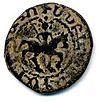
|
1277 Third son of Leo III and Anna of Lampron |
1296–1298 (usurper) |
1310 aged 32–33 |
Unknown (daughter of Mahmud Ghazan Khan) no children |
Sempad seized the throne with the aid of his brother Constantine while his brothers Hethum II and Thoros were in Constantinople. At their return, imprisoned them. He also blinded Hethum and strangled Thoros. |
| Constantine III (Կոստանդին Ա) (Constantine I as king) |

|
1278 Fourth son of Leo III and Anna of Lampron |
1298–1299 | 1310 aged 31–32 |
Unmarried | After helping and then deposing his brother, he was raised as king. Gave the throne to his brother, Hethum II. |
| Leo IV (Լեիոն Գ) (Leo III as king) (under guardianship of Hethum of Armenia[31] (1303–05)) |
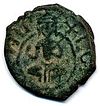
|
1289 Son of Thoros III and Margaret of Cyprus |
1303–1307 | 17 November 1307 Anazarba aged 17–18 |
Agnes of Tyre-Cyprus 1305 no children |
Together with his uncle and previous regent, he fought the Mongols, but were both assassinated in 1307. |
| Oshin (Օշին) |

|
3 January 1283 Fifth son of Leo III and Anna of Lampron |
1307–1320 | 20 July 1320 aged 37 |
Isabella of Korikos c.1310 one son Isabelle of Cyprus 1310 (annulled c.1316) no children Joan of Taranto February 1316 Tarsus one child |
Ascended to the throne after the death of his nephew, Leo IV. He was poisoned by his cousin Oshin of Korikos, who then ascended as regent. |
| Leo V (Լեիոն Դ) (Leo IV as king) (under guardianship of Oshin of Korikos) |
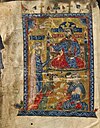
|
1309 Son of Oshin and Isabella of Korikos |
1329–1341 | 28 August 1341 aged 31–32 |
Alice of Korikos 10 August 1321 one child Constance of Sicily 29 December 1331 no children |
Leo was strongly pro-Western and favored a union of the Armenian and Roman Churches, which deeply displeased the native barons. After murdering Leo, they elected a cousin, from the Cypriot Lusignans. |
Houses of Lusignan and Hethum-Neghir
House of Lusignan House of Hethum-Neghir
| Ruler | Born | Reign | Death | Consort | Notes | |
|---|---|---|---|---|---|---|
| Constantine IV (Կոստանդին Բ) (Constantine II as king) |
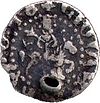
|
c.1300 Son of Amalric, Lord of Tyre and Isabella of Armenia |
1341–1344 | 17 April 1344 aged approximately 43–44 |
Kantakouzene c.1318 Constantinople no children Theodora Syrgiannaina c.1330 two children |
Assassinated in an Armenian revolt in 1344. |
| Constantine V (Կոստանդին Դ) (Constantine III as king) |

|
17 April 1313 Son of Baldwin, Lord of Neghir |
1344–1362 | Marie of Korikos 1340 two children |
21 December 1362 aged approximately 43–44 |
During his rule, Armenian Kingdom of Cilicia was reduced by Mamluk raids and conquests. They conquered Ajazzo in 1347, Tarsus and Adana in 1359. |
| Interregnum: Regency of Marie of Korikos (Մարիա Կոռիկոսի): 1362–1365 | ||||||
| Constantine VI (Կոստանդին Բ) (Constantine IV as king) |

|
c.1324 Son of John, Lord of Neghir |
1365–1373 | April 1373 aged approximately 48–49 |
Marie of Korikos 1369 no children |
Cousin of his predecessor. Allied with Cyprus, and after 1369, with the sultan of Egypt. The barons disliked his policy because they feared the Muslim annexation, and murdered Constantine. |
| Leo VI (Կոստանդին Բ) (Leo V as king) |

|
c.1342 Son of John of Poitiers-Lusignan and Soldana of Georgia |
1373–1375 | 29 November 1393 Paris aged 50–51 |
Margaret of Soissons May 1369 one child |
After several battles against superior Mamluk forces, he locked himself in the fortress at Geben (Armeina: Gaban) and eventually surrendered in 1375,[32] thus putting an end to the Kingdom of Armenia. |
Claimants
| Name | Lifespan | Reign start | Reign end | Notes | Family | Image |
|---|---|---|---|---|---|---|
| Leo VI | 1375 | 1393 | Lusignan |  | ||
| James I | 1396 | 1398 | Lusignan | |||
| Janus | 1398 | 1432 | Lusignan | |||
| John | 1432 | 1458 | Lusignan | |||
| Charlotte | 1458 | 1467 | Lusignan |  |
The title is contested by the House of Savoy.
See also
- List of Armenian royal consorts
- List of rulers of Commagene
- List of monarchs of the Armenian Kingdom of Cilicia
Notes
- ^ a b c d Toumanoff 1990, pp. 506–507.
- ^ Settipani 2006, p. 133, n.4.
- ^ Dédéyan 2007, p. 195.
- ^ a b c Grousset 1947, pp. 242–247.
- ^ (Settipani 2006, pp. 330–334).
- ^ Grousset 1947, p. 264.
- ^ Grousset 1947, p. 272.
- ^ Kingdom of Greater Armenia (Bagratids)
- ^ Sometimes called Maria.
- ^ Probable sister of Ruben I, Prince of Armenia
- ^ (in Armenian) Poghosyan, S.; Katvalyan, M.; Grigoryan, G. et al. Cilician Armenia (Կիլիկյան Հայաստան). Soviet Armenian Encyclopedia. vol. v. Yerevan, Armenian SSR: Armenian Academy of Sciences, 1979, pp. 406–428
- ^ Kurdoghlian, Mihran (1996). Badmoutioun Hayots, Volume II (in Armenian). Athens, Greece: Hradaragoutioun Azkayin Oussoumnagan Khorhourti. pp. 29–56.
- ^ Mutafian, p.90
- ^ Lang, Robert Hamilton (1878), Cyprus, London: Macmillan and Co., p. 179, retrieved 2008-01-15
- ^ Ghazarian, Jacob G. The Armenian Kingdom in Cilicia during the Crusades: The Integration of Cilician Armenians with the Latins (1080–1093).
- ^ a b c d e f g h Cawley, Charles (2009-04-01), Lords of the Mountains, Kings of (Cilician) Armenia (Family of Rupen), Medieval Lands database, Foundation for Medieval Genealogy,[self-published source][better source needed]
- ^ Ghazarian, Jacob G. The Armenian Kingdom in Cilicia during the Crusades: The Integration of Cilician Armenians with the Latins (1080–1093).
- ^ Ghazarian, Jacob G. The Armenian Kingdom in Cilicia during the Crusades: The Integration of Cilician Armenians with the Latins (1080–1093).
- ^ Ghazarian, Jacob G. The Armenian Kingdom in Cilicia during the Crusades: The Integration of Cilician Armenians with the Latins (1080–1093).
- ^ Ghazarian, Jacob G. The Armenian Kingdom in Cilicia during the Crusades: The Integration of Cilician Armenians with the Latins (1080–1093).
- ^ Ghazarian, Jacob G. The Armenian Kingdom in Cilicia during the Crusades: The Integration of Cilician Armenians with the Latins (1080–1093).
- ^ Ghazarian, Jacob G. The Armenian Kingdom in Cilicia during the Crusades: The Integration of Cilician Armenians with the Latins (1080–1093).
- ^ a b Vahan M. Kurkjian (2005-04-05). "A History of Armenia". Website. Bill Thayer. Retrieved 2009-07-19.
- ^ Ghazarian, Jacob G. The Armenian Kingdom in Cilicia during the Crusades: The Integration of Cilician Armenians with the Latins (1080–1093).
- ^ a b Runciman, Steven. A History of the Crusades – Volume II.: The Kingdom of Jerusalem and the Frankish East: 1100–1187.
- ^ Ghazarian, Jacob G. The Armenian Kingdom in Cilicia during the Crusades: The Integration of Cilician Armenians with the Latins (1080–1093).
- ^ Thomas was son of a daughter of Leo I.
- ^ Ghazarian, Jacob G. The Armenian Kingdom in Cilicia during the Crusades: The Integration of Cilician Armenians with the Latins (1080–1093).
- ^ Edwards, Robert W. The Fortifications of Armenian Cilicia.
- ^ Previous regent of Isabella, married her to his son.
- ^ Previously Hethum II.
- ^ Edwards, Robert W. (1987). The Fortifications of Armenian Cilicia: Dumbarton Oaks Studies XXIII. Washington, D.C.: Dumbarton Oaks, Trustees for Harvard University. pp. 10, 125, 234. ISBN 0-88402-163-7.
References
- Boase, T. S. R. (1978). The Cilician Kingdom of Armenia. Edinburgh: Scottish Academic Press. ISBN 0-7073-0145-9.
- Mutafian, Claude (2001). Le Royaume Arménien de Cilicie. Paris: CNRS Editions. ISBN 2-271-05105-3.
- Histoire Des Princes de Lusignan, Anciens Rois de Jérusalem, de la Petite Arménie et de Chypre, St. Petersbourg, Soikine, Stremiannaya 12, 1903.
- Harv and Sfn no-target errors
- Articles with Armenian-language sources (hy)
- CS1 Armenian-language sources (hy)
- All articles with self-published sources
- Articles with self-published sources from August 2012
- All articles lacking reliable references
- Articles lacking reliable references from August 2012
- Articles with short description
- Short description with empty Wikidata description
- Articles contradicting other articles
- AC with 0 elements
- Lists of monarchs
- Lists of Armenian people
- Armenian kings